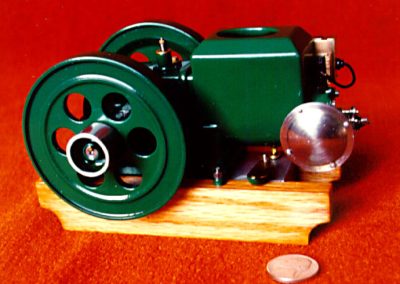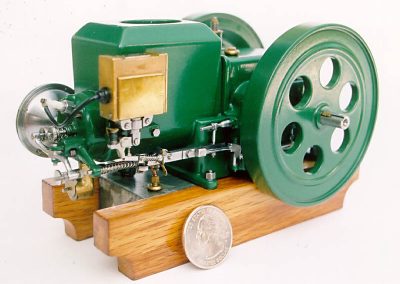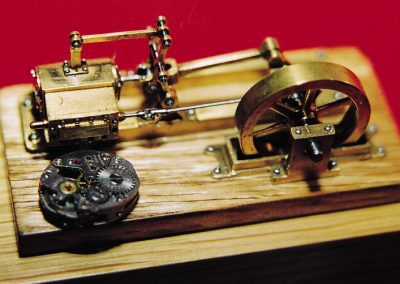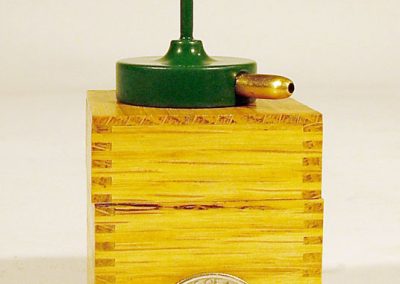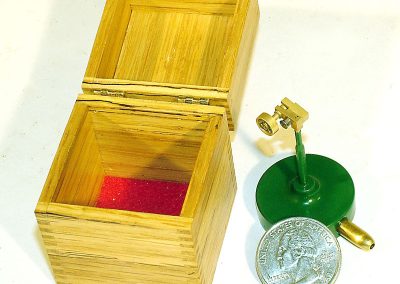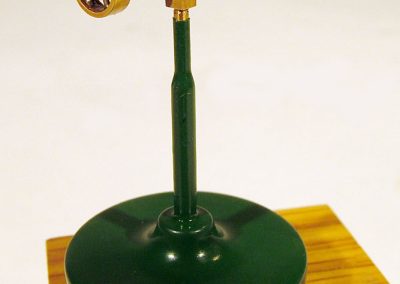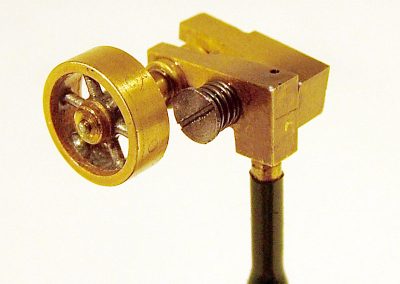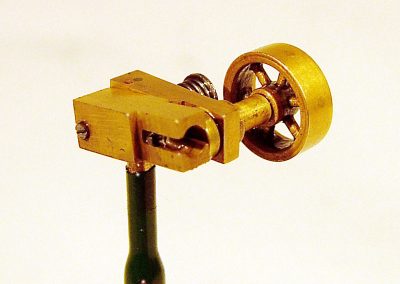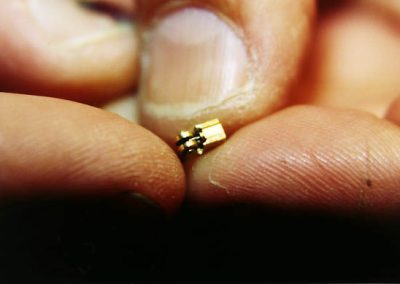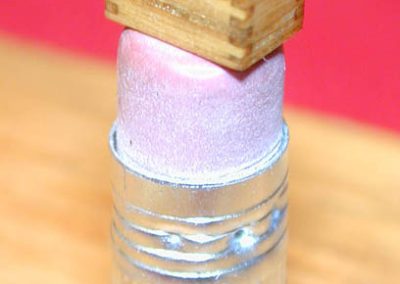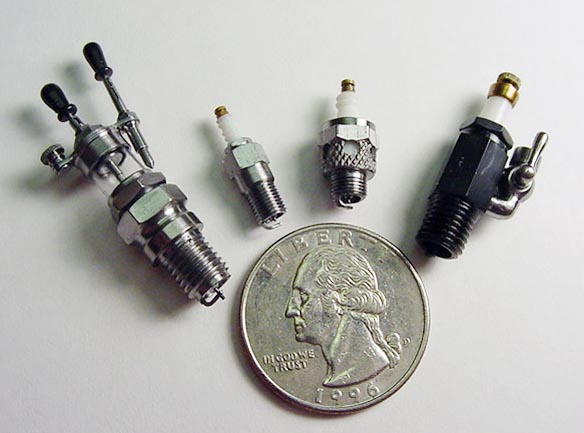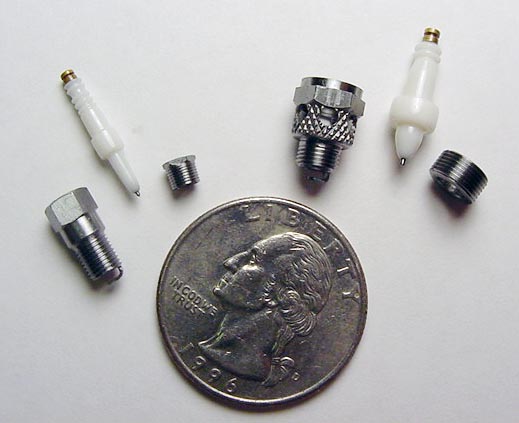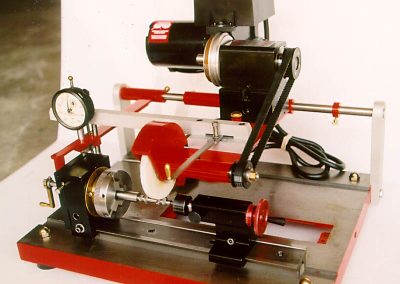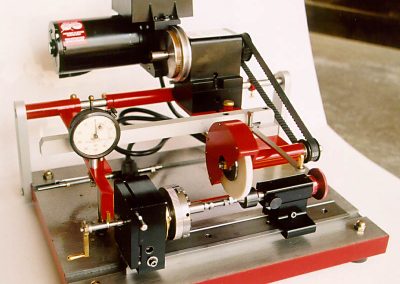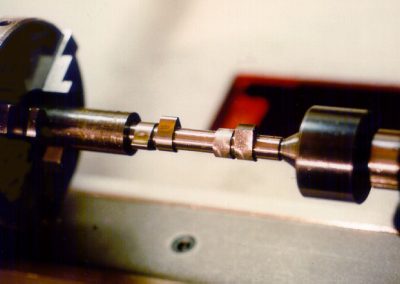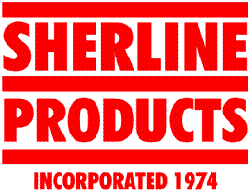A Selection of Jerry’s Other Projects
Jerry Kieffer is a man of many interests. If you’ve already visited his pages on the Harley-Davidson models, John Deere tractor, and so on, it’s evident that Jerry has mastered many areas of expertise. In addition to that, he also does some gunsmithing work, and is making a repeater watch from scratch. While we hope to eventually feature those projects here, Jerry has produced a number of other impressive works—many of which can be seen below.
Scale Model Engines
Stover Hit ’N Miss Engine
Jerry says that although this little Stover hit ‘n miss engine doesn’t look all that impressive, it was quite a challenge. One particularly difficult and unique part of this model is the scale 3/4″ square functional Wico magneto. It took about five hours to wind each of the two coils, and only one out of every five worked.
Stover Hit ’N Miss Engine
Jerry put about 350 hours into the magneto alone, which is visible on this side of the engine. He has not seen another working one this small, and is somewhat proud of it, but said he wouldn’t want to do it again.
The world record holder for “World’s Smallest Steam Engine,” according to The Guinness Book of World Records, is the “Thumbnail Steam Engine” built by Iqbal Ahmed in Nagpur, India. Iqbal is also one of our featured craftsman, and a Lifetime Achievement Award winner. However, the following engine built by Jerry Kieffer is smaller, lighter, and has a flywheel built with a hub, rim and six individual spokes.
Miniature Oscillating Steam Engine
Jerry’s incredibly small oscillating steam engine. The miniature engine is mounted on a stand that allows it to be run when compressed air is supplied to the fitting. A US quarter provides scale reference.
Miniature Oscillating Steam Engine
This is an oscillating engine, rather than a horizontal as built by Mr. Ahmed, so the two are not exactly a direct comparison. Either way, it does make for an interesting discussion.
Miniature Oscillating Steam Engine
Jerry’s microscopic engine sits atop a stand that functions both as a display, and an access point for the air line that runs it. The vertical support is a tube that screws into the intake port to supply pressure to the engine.
Miniature Oscillating Steam Engine
Close-up photos reveal more detail in the engine itself. The miniature is .40” long. (For reference, the width of George Washington’s face on the US quarter is .50”). The flywheel is just .25” in diameter.
Miniature Oscillating Steam Engine
Jerry’s engine has a bore of .059”, and a stroke of .060”. This remarkable miniature is now on display at the Miniature Engineering Craftsmanship Museum in Carlsbad, CA.
Miniature Dual-Flywheel Steam Engine
Speaking of world’s smallest—this project explores the minimum size that a working steam engine can be built. The engine itself is sitting in a tiny oak finger-jointed box, which is dwarfed by the quarter underneath. The engine itself is believed to be the world’s smallest dual-flywheel steam engine.
Miniature Dual-Flywheel Steam Engine
This entire engine will fit inside of the 1/4” flywheel of the already microscopic engine that was detailed prior. It weighs just 3.5 grains. The engine has a bore of .029”, and a stroke of .032”. When Jerry injects air into the .008” intake port with a hypodermic needle, the two little flywheels start spinning away.
Miniature Spark Plugs
Jerry makes the spark plugs for his engines with the same attention to detail as the rest of the model. The plugs pictured below represent four different types of prototype spark plugs, each built at small scale. Referring to the spark plug on the left in the first photo, Jerry said, “The first one is a 1/4 scale Rentz 775 spark intensifier spark plug.” It was designed to give a hotter spark when starting a farm type engine (or others). The engine could be set back to normal spark after starting. The process involves first opening a gap in the glass area before starting. This means that the coil has to build up enough spark to jump the upper gap, as well as the normal gap in the combustion area. This produces a much hotter spark in the combustion area when starting. After the engine starts, the upper gap can be closed for normal running operation, which reduces coil overheating, etc.
Four different spark plugs made by Jerry. From left to right, the first plug is a 1/4 scale Rentz 775 spark intensifier spark plug. The second plug is a standard 1/6 scale Champion plug, typical of what was used in tractors and hit ’n miss engines of the 1920’s-30’s. The third plug is a 1/6 scale Champion air-cooled Harley-Davidson plug, used in early motorcycles. The fourth plug is a 1/4 scale Champion “Toledo” primer plug. The primer plug was used in early cars and other engines for priming each cylinder before starting.
All of the plugs are fully functional, and operate just like the originals. The spark plugs are used to run various model engines while on display at shows. As shown here, each plug also disassembles for cleaning and inspection. All of the insulators were machined from millable ceramic using carbide tooling.
Cam Grinding Machine
In order to be able to make proper cams for his running engines, Jerry designed and built this camshaft grinder. He used the cast iron base from a discarded table saw. The Federal dial indicator was a $10.00 flea market purchase. The rest was made from bar stock. The power is supplied by the headstock/motor/speed control from Jerry’s Sherline lathe. The total cost to build the cam grinder was under $60.00, not including the Sherline power unit. Jerry can grind just about any model engine camshaft with this machine.
Cam Grinding Machine
Jerry’s cam grinding machine has the following specifications: Maximum cam length is 6.00”; max cam diameter is .750”; grinding accuracy is .0003”.
Cam Grinding Machine
In April, 2004 Jerry detailed the construction and use of this tool in a seminar at the NAMES Expo in Detroit.
Return to Jerry Kieffer’s main page.
This section is sponsored by:
Makers of precision miniature machine tools and accessories. Sherline tools are made in the USA.
Sherline is proud to confirm that Jerry Kieffer uses Sherline tools in the production of his small projects.

